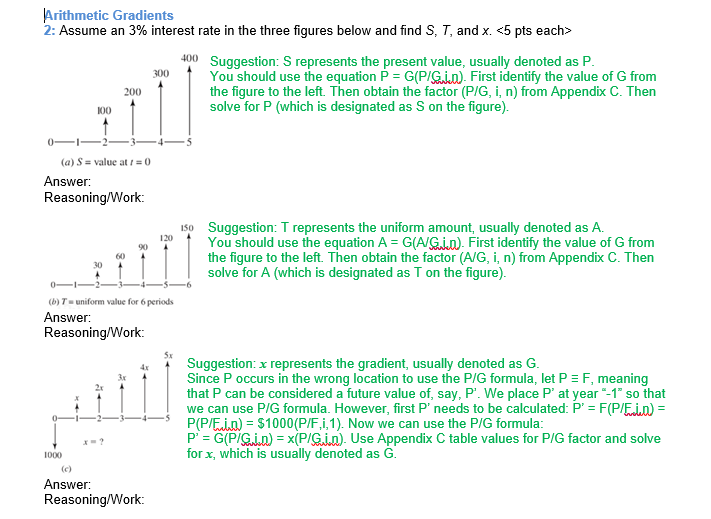I need help in this question. Please do it correctly and accurately, do not make any mistake

Arithmetic Gradients 2: Assume an 3% interest rate in the three figures below and find S, T, and x. 400 Suggestion: S represents the present value, usually denoted as P. You should use the equation P = G(PIG...). First identify the value of G from the figure to the left. Then obtain the factor (P/G, i, n) from Appendix C. Then solve for P (which is designated as S on the figure). 300 200 100 (a) S = value at r = 0 Answer: Reasoning/Work: 120 90 150 Suggestion: T represents the uniform amount, usually denoted as A. You should use the equation A = G(AGIO). First identify the value of G from the figure to the left. Then obtain the factor (A/G, i, n) from Appendix C. Then solve for A (which is designated as T on the figure). (6) Tuniform value for 6 periods Answer: Reasoning/Work: Suggestion: x represents the gradient, usually denoted as G. Since P occurs in the wrong location to use the P/G formula, let P = F, meaning that P can be considered a future value of, say, P. We place P' at year "-1" so that we can use PIG formula. However, first P' needs to be calculated: P = F(P/Ein) = P(P/E) = $1000(P/F,i,1). Now we can use the P/G formula: p=G(PIG.1.0) = x(P/G.In). Use Appendix C table values for P/G factor and solve 1000 for x, which is usually denoted as G. (c) Answer: Reasoning/Work Arithmetic Gradients 2: Assume an 3% interest rate in the three figures below and find S, T, and x. 400 Suggestion: S represents the present value, usually denoted as P. You should use the equation P = G(PIG...). First identify the value of G from the figure to the left. Then obtain the factor (P/G, i, n) from Appendix C. Then solve for P (which is designated as S on the figure). 300 200 100 (a) S = value at r = 0 Answer: Reasoning/Work: 120 90 150 Suggestion: T represents the uniform amount, usually denoted as A. You should use the equation A = G(AGIO). First identify the value of G from the figure to the left. Then obtain the factor (A/G, i, n) from Appendix C. Then solve for A (which is designated as T on the figure). (6) Tuniform value for 6 periods Answer: Reasoning/Work: Suggestion: x represents the gradient, usually denoted as G. Since P occurs in the wrong location to use the P/G formula, let P = F, meaning that P can be considered a future value of, say, P. We place P' at year "-1" so that we can use PIG formula. However, first P' needs to be calculated: P = F(P/Ein) = P(P/E) = $1000(P/F,i,1). Now we can use the P/G formula: p=G(PIG.1.0) = x(P/G.In). Use Appendix C table values for P/G factor and solve 1000 for x, which is usually denoted as G. (c) Answer: Reasoning/Work







